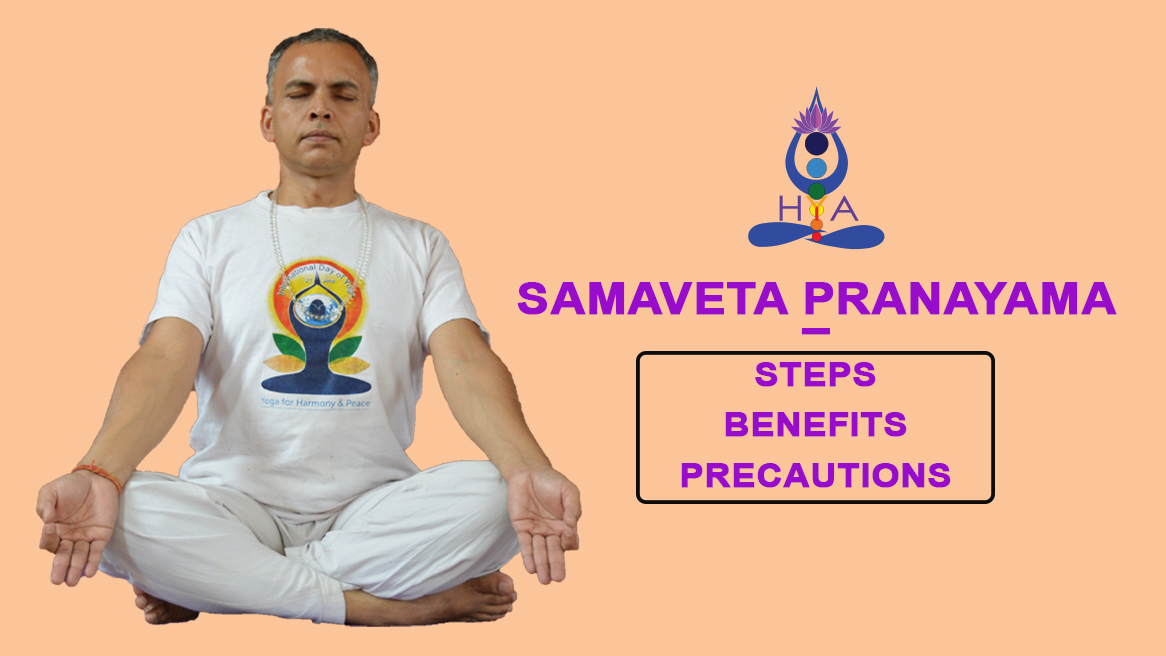
2 Nov 2023 HYN Himalayan Yoga Academy
Samaveta Pranayama (The First Pranayama) – Steps, Benefits, Precautions
Samaveta Pranayama is a delightful and simple pranayama practice that allows you to breathe through both nostrils at the same time. The word “Samaveta” comes from Sanskrit and means “together”. This is a fantastic technique and is often described as simple and easy to do. Many sources highlight this technique as a fundamental practice in the world of pranayama. It provides the perfect warm-up for more advanced pranayama practices, preparing your mind and body for the incredible journey that lies ahead. So, take a deep breath and get ready to explore the harmonious union of both nostrils in Samaveta Pranayama. Let the energy flow and embrace the simplicity of this beautiful practice.
Pranayama and Energy Balance
When we practice pranayama, there are different forms of energy within us that are closely related to our health, our thoughts, and our reactions to the outside world. These energies, known as prana, can be both subtle and gross.
Although some forms of energy, while some of the energy sources, such as nervous energy and chemical energy, are well known, others are not commonly observed in daily life. Pranayama aims to harmonize and manipulate these energies, with the control and manipulation of breathing playing a key role.
Samaveta Pranayama Steps/Procedure
- Sit in a comfortable position, preferably in one of the meditation asanas.
- If meditation asanas are uncomfortable, you can sit on a chair or against a wall with your feet extended. Make sure your spine remains straight.
- Close your eyes.
- Begin yoga breathing, focusing on moving your stomach and chest as rhythmically as possible. Breathe in and out in a wave motion from your stomach to your chest and breathe out in a wave motion from your chest to your stomach. Breathe deeply and effortlessly, exhaling and inhaling as much air as possible.
- Keep your eyes closed throughout the exercise and continue this breathing pattern for a few minutes.
- Start practicing Samaveta Pranayama: At the end of inhalation, hold your breath for about a second without straining, and then exhale. Make sure your breathing remains slow and comfortable.
- Exhale as much air as possible and then inhale. Hold your breath briefly again and breathe out. Repeat this cycle throughout your workout.
- Breath-hold time: Gradually increase your breath-hold time from about one second to a maximum of ten seconds over the course of several weeks. It is important not to hold your breath longer than necessary. Regular practice will naturally increase the amount of time you can hold your breath.
Duration
Start with a short duration, e.g., E.g. 5 minutes, and increase gradually based on your comfort and progress. The duration of the internship can be extended depending on individual possibilities and needs.
Timing of Practice
Samaveta Pranayama can be practiced at any time of the day, preferably on an empty stomach. However, it is generally recommended to practice pranayama in the early morning or evening when the body and mind are relatively calm.
Samaveta Pranayama Precautions
• It is important to practice Samaveta Pranayama under the supervision of a qualified yoga teacher. Especially if you are new to pranayama practice or suffer from respiratory or circulatory diseases.
• When practicing, avoid straining and tiring your breathing. Maintain a comfortable and natural breathing rhythm.
• If you feel dizzy, uncomfortable, or short of breath, stop practicing and consult a yoga instructor or healthcare professional.
• Make sure your study environment is clean, well-ventilated, and free of distractions.
Samaveta Pranayama Benefits
• Preparation for advanced pranayama exercises:
Samaveta pranayama helps prepare the lungs for more advanced pranayama techniques.
• Increased Oxygen Exchange:
During breath holding in Samaveta Pranayama, the exchange of oxygen between the blood and lungs and the release of carbon dioxide between the lungs and blood increases.
• Calming and balancing effects:
The rhythmic breathing pattern of Samaveta Pranayama promotes a feeling of peace and balance in the mind and body.
• Improved respiratory function:
Regular practice of Samaveta Pranayama strengthens the respiratory muscles, increases lung capacity, and improves overall respiratory function.
• Increased Energy Flow:
By harmonizing and manipulating subtle and gross forms of energy (Prana), Samaveta Pranayama helps to optimize the flow of energy throughout the body, resulting in increased vitality and overall well-being.
• Stress reduction:
Deep, mindful breathing combined with Samaveta pranayama activates the parasympathetic nervous system, promotes relaxation, reduces stress, and improves mental clarity.
• Detoxification:
The increased exchange of oxygen and carbon dioxide during respiratory arrest helps remove toxins from the body, supporting the detoxification process.
• Mind-Body Connection:
Samaveta Pranayama cultivates a deeper awareness of breathing and strengthens the mind-body connection, promoting a state of awareness and inner harmony.
Learn everything about various pranayama from authentic sources.
Reference Books:
- Asana Pranayama Mudra Bandha by Swami Satyananda Saraswati
- The science Of Pranayama by Sri Sivananda.
- Light on Pranayama by B.K.S Iyengar.
